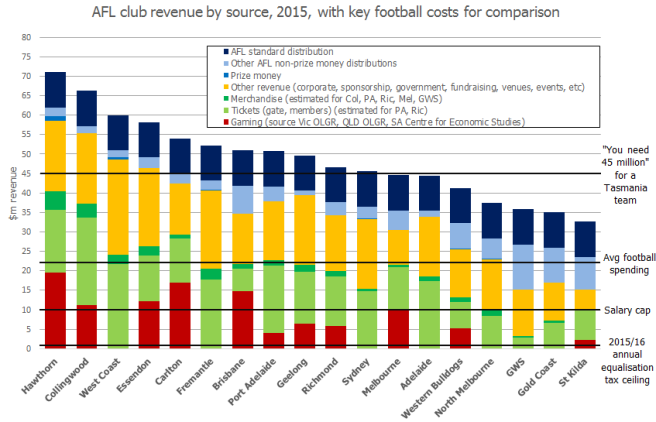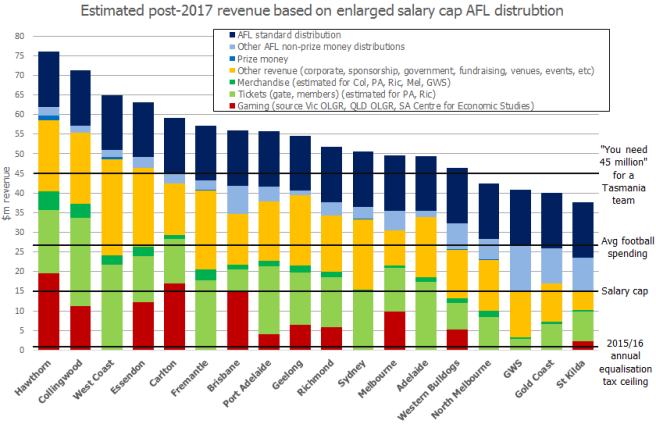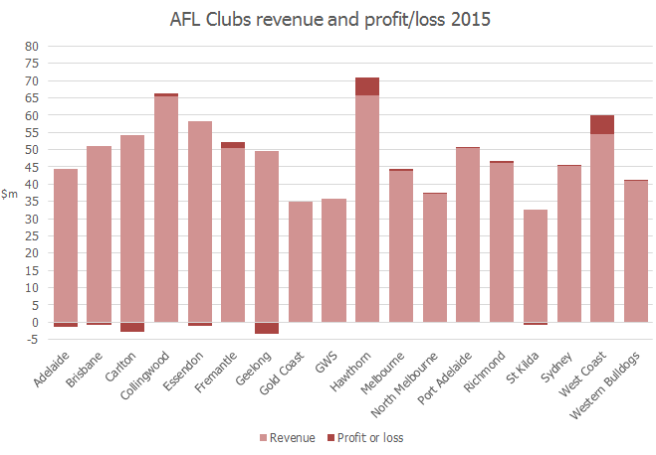AFL finances can be a bit murky and opaque and are very important to understanding the debate around financial equalisation. Luckily thanks to public annual reports we can roughly chart the financial size and position of each club. Thanks to the sterling work of The_Wookie at Footy Industry and Bigfooty in compiling annual reports (including those only available from ASIC), we can present the following charts.
Firstly, for an “all-in” picture of the size of each club’s annual takings, we’ve taken revenue figures from annual reports and combined it with AFL, gaming and other data to tell us about the overall income picture for AFL clubs:

There’s a bit to talk through here.
Extra AFL support for the expansion sides is usually wildly overstated
Often reported as “pouring over 20 million dollars in” by the AFL or “subsidised over 100m dollars” since inception, the truer picture of the AFL’s current extra support for GWS is currently 3-5 million extra dollars per year, when compared to other small teams like St Kilda or the Bulldogs. It’s important to note that half the money that the Giants receive is the standard allotment for all clubs. And it’s perhaps even more important to note that this TV deal is as large as it is thanks in part to the existence of a 9th game and two teams in each mainland state. Furthermore, as small clubs, GWS and Gold Coast would be getting a few extra million dollars in equalisation funding regardless of their status as expansion clubs.
Prize money is minimal
Prize money is about $1m for the premier. We were last able to find it reported for 2014. This stands in stark contrast to the English Premier League, where a full 25% of the TV rights money is distributed according to finishing position.
Clubs get a lot of pokies money
It should be stressed that clubs don’t pocket all pokies money as pure revenue. Club venues have operating costs.
For example, Brisbane’s Springwood venue operated at about a $3.8m profit in 2015, costing $12m to run and bringing in $15.8m. That’s including an estimated $14.8m in pokies revenue using the assumption that their 200 machines operate at the average productivity of Logan’s ~2000 machines. Most AFL clubs don’t report their venue operating costs specifically, but we can assume they’re not running as charities and that pokies are a big part of those operations’ revenue picture.
Football itself currently costs about $20m to run, plus back office costs
We’ve included as important context the salary cap, the average football department spend and also the $45m in revenue that Gillon McLachlan gave as a minimum benchmark for a potential Tasmanian side in future.
If we use the expansion sides and small Victorian teams as the model, the bare minimum to run a club seems to be about 50% more than the cost of the football department, judging by the size of the smallest clubs’ revenue flows. The rest of these costs would be things like ground hire, cost of facilities, non-football salaries, equipment, administration and other costs.
Gillon’s estimate of $45m seems to be inflated, especially by the presence at many clubs of high cost, high revenue pokies-based establishments. After AFL money, it looks more like about $22-$25m of local revenue would be a more plausible target, but that would be greatly affected by the geographical location of the team. We would suggest that a potential Tasmanian AFL team would be significantly cheaper to establish and run, due to the costs of operating, than a new football team in Perth, due to Government support and the cost of real estate.
It is also clear why a number of clubs are alarmed at the potential for an off-field spending arms race, with the clubs at the lower end clearly looking unable to compete if football spending keeps rising without commensurate AFL support.
The standard distributions will change a lot with the new broadcast deal
The AFL standard distributions are largely made up of TV (and other) rights money, and this will likely increase in line with the new broadcast deal (and consequently the salary cap). Expect some big movement on this front from next year.
The rest of the AFL money is a mixture of items. A big share is disequal funding because some clubs get several million dollars extra money due to simple need or due to specific structural projects. Other shares include Etihad Stadium signage rights and promotional and marketing money given to clubs, including the Giants’ and Suns’ extra start-up funds.
With the new AFL broadcast deal reported to be perhaps 67% bigger than the current one, we can expect the dark blue share of club revenues to increase a lot, commensurate with an enlarged salary cap. If we assume a negotiated cap enlargement of 50%, funded for clubs by the AFL’s standard distribution, revenues could look like this in 2017 or soon after:

Note that with a 50% increase to the salary cap you still don’t need $45m to run an AFL club.
Expanding the picture
Current revenue is not the entire picture with any business including AFL clubs. Another important component is a club’s assets and liabilities – what they own and what they owe. The balance of these tells us how much a club is worth. Clubs like Hawthorn, Collingwood, Essendon and West Coast own significant assets with much smaller liabilities while a number of clubs own very little or have significant debts relative to what they own.

Finally, we need to remember that while over the long run revenue tells us about club spending constraints, revenue isn’t the whole picture. Most income isn’t free and must be earned with expenditure. A club can have high revenue and still run losses, and eventually get themselves into a terrible position with burdensome debt.
Here is each club’s total revenue in the year to October 2015, along with whether they reported a statutory profit or loss:

For example, half of Geelong’s statutory loss is the write-off of demolishing two stands at Kardinia Park, whilst Hawthorn had a million dollars in premiership prize money contributing to its big profit. In the long run, a persistent profit or loss creates a meaningful picture (it is clear that West Coast have an incredible financial position), but one year’s profit or loss can’t tell us a lot in isolation.
Coming soon: is there a fairer model for AFL funding distribution? And what would the funding of each club look like if the AFL followed the revenue sharing leads of some other sporting leagues around the world?

What exactly is gaming revenue? Why don’t West Coast or Fremantle have any while Hawthorn and Carlton have loads?
LikeLike
It’s pokies revenue, ie losses obtained or estimated from regulator data. West Coast and Fremantle are among the clubs that don’t own any pokies, partly because Western Australia doesn’t allow them outside the casino.
LikeLike
WA tells a good story
LikeLike
Very good article. thanks for publishing. Do you have the SA clubs assets and liabilities?
LikeLike
Hi Bernie,
The missing clubs weren’t in the bigfooty threads we compiled the data from. Presumably that detail wasn’t in their annual reports.
LikeLike
Hi Sean,
Thanks for the article – interesting reading.
A follow up on an earlier question: any thoughts on why the 5 other (non-WA) clubs (Sydney, Adelaide, NM, GWS, Gold Coast) don’t earn any pokies revenue? My understanding is that the NRL clubs earns stacks from gaming, so it’s surprising that the AFL clubs in NSW and Qld aren’t similarly into it. I’m kind of hoping they’ve abstained on moral grounds, but I doubt that’s it.
LikeLike
Hi Paul, here’s my take:
The Crows were always an SANFL owned venture and there would have been no reason to pad their balance sheet with high cost assets like that. Such a venture would have been direct competition to SANFL club venues. South Australia also seems to have the least profitable most tightly regulated pokies so wouldn’t make much money. Port’s social club and other hotel I believe predate the AFL club and may have been transferred from the Magpies during the One Club move. Certainly Port historically would have been keener for an independent asset base than the Crows.
Sydney had a relationship (unsure if ownership) with the Australian Rules Social Club in Kings Cross for a number of years bit it went under. I think in terms of assets they’re focused on the Swans Foundation and an expensive new HQ to replace their rented digs at the SCG itself.
GWS are pretty new and don’t own much of anything. Their big asset venture so far has been as a partner in the proposed and shitcanned Manuka Oval development which would have been mostly apartments and hotel with a token oval upgrade – all on alienated ACT Govt leasehold public land.
I think also NSW is pretty saturated in pokies and there may be a rule where sale transfer of licenses have to be accompanied by surrender/withdrawal of others?
Gold Coast are also new. Southport Football Club are like their third biggest sponsor and the president is on the Suns board. Southport is also one of the richest AFL clubs outside the AFL – remember when they tried to buy North? I reckon the Suns don’t need to operate pokies themselves.
I think with North it’s a mixture of virtue signalling, poor past experience and pragmatism (the 1-2m profit margin on a small club venture isn’t THAT vital surely)
LikeLike
Thanks for the quick response, Sean. I had kind of suspected that the Swans and Giants were not in the game because of (rather than despite) the heavy presence of pokies in NSW. Anyway, thanks again.
LikeLike